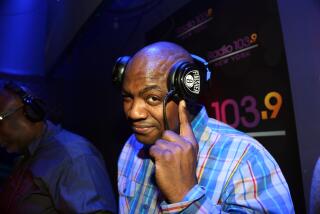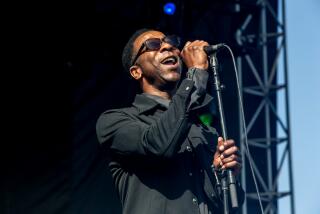From the Archives: Jazz Great Thelonious Monk Dies
Jazz visionary Thelonious Monk, a musical maverick whose artistry and originality as composer and pianist made for him a permanent place wherever jazz is heard, died Wednesday in Englewood, N.J. at 64.
“The Monk is dead,” a spokesman at Englewood Hospital announced shortly after the musician died at 8:10 a.m.
Monk, who had not performed in public since the middle 1970s, suffered an apparent stroke Feb. 5 at his home in Weehawken, N.J. He was admitted to the hospital the same day. Doctors said his condition was complicated by hepatitis.
Playing with and sparking exchanges of advanced musical ideas with giants such as saxophonist Charlie (Bird) Parker, guitarist Charlie Christian and trumpeter Dizzy Gillespie, the pianist was one of the inventors of the once controversial jazz form known as be-bop or simply bop.
Hip hipsters called Monk “The High Priest of Be-bop.”
Monk’s musical style was described as “unorthodox, angular, spare and somber.”
His life style was sometimes bizarre. Reclusive and difficult to talk to, he occasionally lapsed into silences that lasted for days. He also went for days without sleep, prowling his apartment in Manhattan’s San Juan Hill neighborhood or wandering the streets, now and then breaking into odd dances on the sidewalk.
Goateed and solemnly handsome, Monk loved strange headgear—fur hats and Chinese skullcaps were favorites—and he once decorated himself outlandishly with a collard-greens boutonniere.
The musician also was given to making mysterious remarks, such as “It’s always night or we wouldn’t need light!” to which Monk-cultists were inclined to ascribe deeper meanings than he probably intended.
Monk hit his stride as a musician, composer and jazz celebrity between the mid-50s and the mid-60s, after more than two decades of comparative obscurity.
Dizzy Gillespie, who had known Monk since 1937, said his old friend’s death is a heavy blow to music.
“Monk’s contribution hasn’t really reached full fruition,” Gillespie said. “People haven’t given him the credit he deserves—it probably will take a little more time to show his true influence on the music scene in America. But I’m sure that when all is said and done, he will stand up as tall as any composer or instrumentalist America has produced.”
Monk’s most famous composition is “ ‘Round Midnight,” which has become a jazz standard.
Other standards created by Monk include “Misterioso,” “Ruby My Dear,” “Epistrophy” and “Blue Monk.” With Jack Murray he composed the score for the Roger Vadim motion picture “Les Liaisons Dangereuses.”
Although the year of Monk’s birth has been listed variously as 1918 and 1920, Times critic and jazz historian Leonard Feather said he has a copy of a birth certificate giving Oct. 10, 1917, as Monk’s natal date.
Born in Rocky Mount, N.C., as Thelius Monk, he was taken by his parents to New York City as a child. He grew up and lived for more than four decades in his mother’s apartment in San Juan Hill. When he married Nellie Smith in 1947, she moved into the same apartment.
Began Playing by Ear
Monk began playing piano by ear at 6 and took a few formal lessons a few years later, but was largely self-taught. Part of his eductaion was listening to such legendary jazz pianists as Fats Waller, James P. Johnson, Earl (Fatha) Hines, Duke Ellington and Teddy Wilson, all of whom he greatly admired but did not directly imitate.
By the time he was 13, Monk was playing in local bands in Harlem and at “rent parties” where pianists competed for applause and small change.
One story is that he played and won so often at the Wednesday night amateur shows at the famed Apollo Theater that the manager eventually barred him from competition.
Monk quit high school at 16 to devote himself full time to music, touring for a year with an evangelist and faith healer. “She healed and I played,” he recalled many years later.
In the musically ripe days before World War II, Monk played in the house band at Minton’s in Harlem, where such musicians as Parker, Christian, Gillespie, Bud Powell and Kenny Clarke often sat in. It was during this period that they began developing the innovative style that later became known as be-bop.
Although he worked as a sideman with the bands of Lucky Millander, Gillespie and Coleman Hawkins, he performed mainly with his own trios or small combos.
Served Jail Term
Neglected for many years, he began to come into his own on 52nd Street as composer, pianist and leader in the early 1950s, although his career suffered a setback in 1951 when he was arrested and served a 60-day jail term for possession of heroin.
His career was greatly aided by the Baroness Pannonica de Koenigswarter, who also was a close friend of Parker and in whose apartment the saxophone great died in 1955.
By 1957, Monk was heading a highly successful quartet at the then-famous Five Spot Cafe. His featured sideman was saxophonist John Coltrane.
By the mid-1960s, Monk was an international jazz star with a cult following, especially in Europe, his every chord analyzed, his every quote treasured.
And some of his quotes were pithy indeed. In Holland an interviewer asked, “Who has had the greatest influence on your playing, Mr. Monk?”
“Well, me, of course,” he replied.
In an advisory mood, he once commented: “A man’s a genius just for looking like himself. Play yourself.”
Through the early ‘70s, he continued to perform successfully at clubs and jazz festivals, usually leading a quartet. His last publicized performance in Los Angeles was in 1972 at Shelley’s Manne Hole.
“Monk offered the same jagged arpeggios, odd voicings and peculiar articulation that established him long ago as one of the most individualistic pianists of jazz history,” wrote critic Feather at the time.
New Yorker magazine critic Whitney Balliett once wrote that although Monk’s tunes “ripple with dissonances and rhythms that often give one the sensation of missing the bottom step in the dark, they are generally written in simple riff figures that rarely stray from accepted chord structures. The best . . . display minor brooding of pure, unsentimental lullabies.”
Martin Williams of Saturday Review called Monk “a major jazz composer, the first since Ellington.”
In addition to his wife, Monk leaves a son, Thelonious Jr., who is a drummer, and a daughter, “Boo-Boo.” a singer. They head a jazz-rock group called T.S. Monk.
Funeral arrangements are pending.
From the Archives: Princess Margaret, 71; Sister of the Queen
From the Archives: Renowed Jazz Bassist Charles Mingus Dies at 56
From the Archives: Beat Generation’s Jack Kerouac Dies at 47
From the Archives: Novelist Ernest Hemingway Dies of Gun Wounds
From the Archives: Earl Warren Dies at 83; Chief Justice for 16 Years
More to Read
Start your day right
Sign up for Essential California for the L.A. Times biggest news, features and recommendations in your inbox six days a week.
You may occasionally receive promotional content from the Los Angeles Times.






